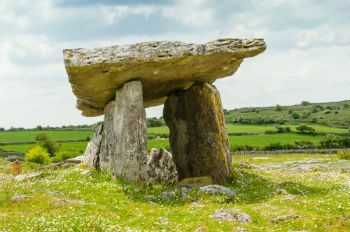O Neolithic Period (from 8000 to Ç. up to 5000 a. C.), also called Polished Stone Age it is the second in prehistory and its main characteristic is the development of agro-pastoral societies.
 "Dolmen Poulnabrone", Neolithic Tomb Portal, Ireland
"Dolmen Poulnabrone", Neolithic Tomb Portal, Ireland
This period is called the Polished Stone Age, since the instruments began to be produced by polishing the stone and working on the cutting edge.
In this sense, it is noteworthy that the previous period, the Paleolithic, is called the Age of the Chipped Stone, since the stone did not receive this treatment. From the Greek, the neolithic term (neo "new" and lithos "stone") means "new stone" or "new stone age".
In climatic and geological terms, there was a big change in the Neolithic period, as the level of the seas, there was the formation of deserts, causing several populations to move, which came to live close to the rivers.
Prehistory Divisions
THE Prehistory it is the oldest period in the history of men, which indicates the emergence of humanity. It is divided into three major periods, also called Ages, ranging from the appearance of the human being to the invention of Writing:
- Paleolithic or Chipped Stone Age (from the emergence of mankind to 8000 BC Ç.)
- Neolithic or Polished Stone Age (from 8000 to Ç. up to 5000 a. Ç.);
- age of metals (5000 a. Ç. until the appearance of writing, around 3500 BC. Ç.).
Main Features: Summary
The Neolithic period is mainly related to the sedentarization of man and consequently to the development of agricultural and grazing activities.
Thus, with this change in posture, a new way of life was inaugurated, from which Neolithic man began to relate to nature, cultivating plants, as well as domesticating animals.
Note that man from the previous prehistoric period (Paleolithic) was nomadic, that is, he constantly took off in search of shelter and food (hunters and gatherers),
For this reason, the Neolithic is considered an important milestone in the development of society and changes in socio-cultural relations, which has come to be called, by historians, as the “Neolithic Revolution” or “Agricultural and Pastoral Revolution”.
Working with the land, growing food (wheat, rice, corn, cassava, potatoes, etc.) and raising animals (ox, pigs, sheep, horses, etc.) was essential for the development of societies in the Neolithic period, as well as for the growth of population.
This was possible through the domination of agricultural and pastoral techniques. Men were beginning to stock up on food and therefore survive the seasons that were harder to find food. Indeed, we can intuit that the expectation and quality of life of Neolithic men increased in relation to the previous period.
However, some historians believe that village life in the Neolithic period reduces, in part, the life expectancy of some nuclei of villages, as they could have favored the proliferation of diseases and epidemics, leading to the death of a large part of the population. population; and still in some centers, for example, which only cultivated cereals, suffered from nutritional deficiencies.
It is important to make it clear that this process in the change in man's life occurred slowly and not for that reason, all individuals stopped being nomads, hunters and gatherers.
Among the main technical innovations seen in the Neolithic period we have:
- Production of polished stone tools (knives, axes, hoes);
- Building houses to shelter themselves (wood, stone, clay, foliage, etc.)
- Ceramic objects (utensils for cooking and storing food)
- Development of weaving (animal fur and leather and vegetable fibers)
At the end of the Neolithic period, around 4000 BC. Ç. metallurgy begins to develop with the production of copper, bronze and iron, which will slowly replace stone, the most important raw material of the Stone Age. The development of metallurgy enabled the creation of several very resistant instruments and of the most varied forms.
Art in the Neolithic Period
With the creation of new stone polishing techniques, many artistic objects made of ceramic and animal skin began to be produced in this period. Note that peoples did not consider these objects works of art, which had a utilitarian character, that is, they were produced to be used, whether for the transport of food, drink, clothing.
On the other hand, the art objects produced by the artists (considered enlightened beings) acquire a character religious, that is, supernatural and magical, for example, in the amulets and religious symbols created in this time course.
Thus, many of them were used in rituals and cults, which were involved in an atmosphere of magic. In addition, the Neolithic man began to build shelters and houses, being therefore considered the first architects of humanity.
To learn more, read:
- Art in the Neolithic Period
- Art in Prehistory
- Prehistory: Periods and Characteristics



